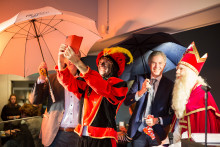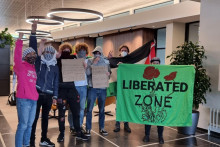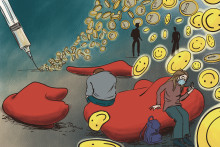What is it actually?
In the middle of November (in 2020 it was on the 15th), Sinterklaas and his helpers arrive from Spain on his steamboat called ‘Pakjesboot 13’, in which they transport presents for all children of the Netherlands that have behaved well. They arrive in a different city every year which comes with a big celebration. Once they have arrived, Sinterklaas rides through the city on his horse. In 2019 his famous horse ‘Amerigo’ retired and ‘Ozosnel’ (‘O so fast’) took over his job.
On the evening of the 5th of December the main festival called ‘Pakjesavond’ takes place. Up till then the children put their shoes in front of the chimney (or the door if they don’t have a chimney) with their wishlist, carrots and water for Ozosnel and they sing songs to tell Sinterklaas how much they appreciate him and how excited they are for their presents. If they do well, they will have small presents and treats in their shoes the next day. When people grow too old to receive presents from Sinterklaas and his helpers, people tend to buy presents for each other and write poems to joke about the person they are writing about.
Corona
This year the big entry of Sinterklaas could not happen the normal way, as that would give the pandemic a chance to spread even more. Therefore the government decided to come up with a fake city called ‘Zwalk’. Because the city does not really exist, people did not know where the entry would be filmed and there were no big crowds to handle. The specific Sinterklaasjournaal (a news show about Sinterklaas for children that airs a few days before his arrival and is live every day until the fifth of December) was there to show the children the arrival. Prime minister Mark Rutte announced that Dutch citizens are not allowed to have a big ‘Pakjesavond’ this year, with all the family present. Sinterklaas also has to take care of the corona measurements of course.
Origins of it
Sinterklaas is based on the bishop Saint Nicolaas, who lived in Myre (Demre), Turkey in the year 300 AD. He’s been known to care for the poor and free slaves. He once saw a man with three daughters who did not have enough money to support the family, let alone give his daughters any presents. To earn money for food he wanted to send his daughters into prostitution, which Saint Nicolaas could not accept. Saint Nicolaas secretly threw money through the window which ended up in the shoes of the daughters. And so, the myth was born.
Although celebrating Saint Nicolaas has existed for many years, the modern version was invented by a teacher called Jan Schenkman who wrote a book about Sinterklaas in the 19th century. In this book, the helper of Sinterklaas was a freed slave called ‘Zwarte Piet’. Since 2013, the integrity of this ‘Zwarte Piet’ (‘Black Pete’) has been under a magnifying glass, and the appearance of the helpers has changed since then.
The discussion
Over the past years, the discussion surrounding Black Pete has seen an immense growth across the spectrum of opinions. The reason behind Black Pete’s controversy is the visual appearance which many people claim to be stereotyping Black people, due to him wearing all black face paint as well as red lips and a curly wig. While this has been a topic of discussion every year as soon as winter comes closer, the events surrounding the Black Lives Matter movement this year sparked yet a new appeal for change in Black Pete’s appearance.
Across 2020, protesters around the country and beyond called to either ‘keep the tradition alive’ or to Kick Out Zwarte Piet - the opinions and voices differ. While the ‘Zwarte Pieten Actiegroep’ put up posters welcoming the ‘traditional’ Zwarte Piet to Enschede and the region, local libraries started removing books that showcase Black Pete from their shelves.
As the voices become louder on both ends, social media are starting to take action as well. Facebook recently announced the ban of any imagery depicting Black Pete. Many people celebrated it as an achievement, whereas others including emeritus UT Professor Jan van Dijk warned about this censorship. A petition from the Twente region could not change Facebook’s ban, despite collecting 177.000 signatures.
The current situation
While last year’s arrival of Sinterklaas in Enschede included traditional Black Petes, it is not sure how post-corona celebrations will look like. With festivities being cancelled across the Netherlands due to the ongoing pandemic, it raises the question if the impact of the cancellations happens to be the last straw in the abolishment of the tradition from the public eye.
The unclarity is also seen locally. Multiple municipalities choose to replace the traditional Black Pete with a ‘sooty’ Pete (in Dutch: roetveegpiet). While Prime Minister Rutte had a change of mind in June about the appearance of Black Pete, he doesn’t want the government to force a change. So neither the City of Enschede nor the university have yet taken an official position for or against changing the appearance of Black Pete.







